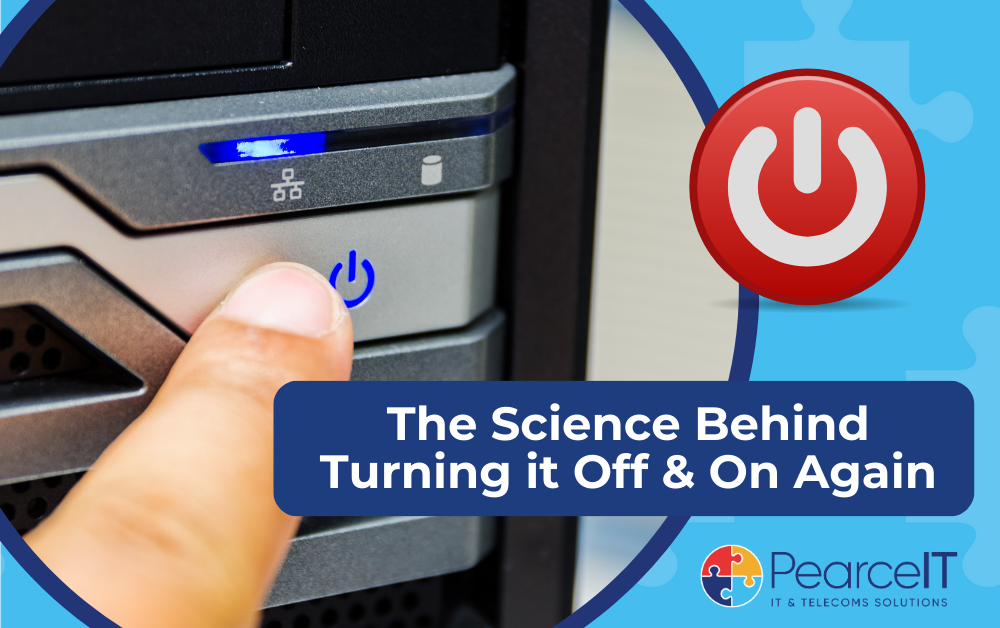We’ve all been there before – having problems with your tech being slow, not responding, or just not working in the way it’s supposed to. The common piece of advice that we’re always told by IT professionals seems to be “just turn it off and back on again”. But is there really any scientific truth to this simple method that seems to work like magic?
Power cycling is the proper term for this solution, usually achieved by holding the device’s power button for a few seconds to force it to turn off or unplugging it from the wall to cut off any power. When you turn off a device, all its running programs and processes are terminated, letting the system reset to a clean slate and potentially stopping any issues that were previously causing problems. Power cycling can help with a wide range of devices, whether it’s your computer itself, your phone, your internet router, or even a device like a printer or photocopier.
When your device has been running for extended periods, it’s not uncommon for performance issues to pop up. This is because as a device runs, it can accumulate temporary glitches such as memory leaks. Furthermore, a device that has been on for a long time may be more likely to overheat. Power cycling can resolve both of these issues by giving your computer a quick break.
Generally speaking, power cycling should be one of your first steps for troubleshooting an issue. Processing issues can be caused by factors such as stuck processes – more specifically, when a system is being slowed down or has crashed because of too many processes happening at the same time, but there’s more to it than that. Power cycling is a versatile solution that can address a wide range of common issues.
Speed boost. A simple reboot can clear any ongoing applications and processes that might be slowing down your device, taking up valuable RAM (essentially the device’s short-term memory) space, and helping to improve overall performance.
Resetting settings. It’s possible that you may have inadvertently changed several configuration settings in the system or a program, causing your device to perform less efficiently or stop responding. By power cycling, these configurations may be reset back to normal, allowing you to get back to regular performance.
Software updates. It’s possible that your device is slowing down because it’s trying to install an update. Many software updates require a reboot to take effect, which can in turn enhance your device’s functionality, performance, and security.
Network connection problems. Perhaps the issue isn’t to do with the device’s performance, but its network connection. Power cycling can effectively reset your connection and restore stability.
In many cases, power cycling can be a quick fix to issues such as frozen screens, programs not opening, or devices not being able to connect. Being able to confidently power cycle your devices is a key part of integrating technology into your business, allowing you to save valuable time by fixing what may be a simple issue by yourself instead of calling for a technician or waiting for remote support. Furthermore, by power cycling, you mitigate any potential long-term risks to your device’s performance by nipping small issues in the bud before they develop into more significant problems, such as taking up hard drive space, overheating causing damage to internal components and making them perform less efficiently, or in rare cases, data loss or corruption.
Did you know? Even huge companies such as NASA use power cycling as a simple solution to their tech problems. In 1971 during the Apollo 14 mission, the landing radar was unable to lock onto the moon’s surface to safely land. Mission control told the astronauts aboard the spacecraft to turn off the radar and turn it back on, allowing them to land safely just in time.
There are some cases where power cycling may not be the right solution. Power cycling isn’t a magic solution to every tech problem, as most of us have probably experienced before, it doesn’t always work perfectly. Furthermore, power cycling can cause you to lose unsaved data, or in rare cases, cause damage to system files by not shutting off the device correctly. If possible, it’s always best to turn off your device through the start or home menu, rather than forcing it off by pressing the power button or disconnecting the power. You may also find that it helps to wait for several minutes before restarting your device.
So, next time you reach for the phone to call for support, remember the simple solution of turning it off and back on again that you can easily try for yourself. It may also help to try this several times or try power cycling other connected devices such as the power supply, Bluetooth devices or your internet router.
At Pearce IT, we provide a range of IT support options. 90% of issues can be resolved remotely, so by getting in touch with us, you’ll be saving time and getting your business working again with minimal disruption. We provide assistance with issues relating to internet connectivity, data loss, hardware and software performance, and printing and copying. As always, we are always here to help with your IT problems and will gladly offer advice or assistance regardless of your problem.
You can always log an IT support ticket with us, whenever you need it, whether or not you are a client, and whether or not it’s within office hours, we’ll do our best to get you back on track as soon as possible. https://shorturl.at/lAHY0.



